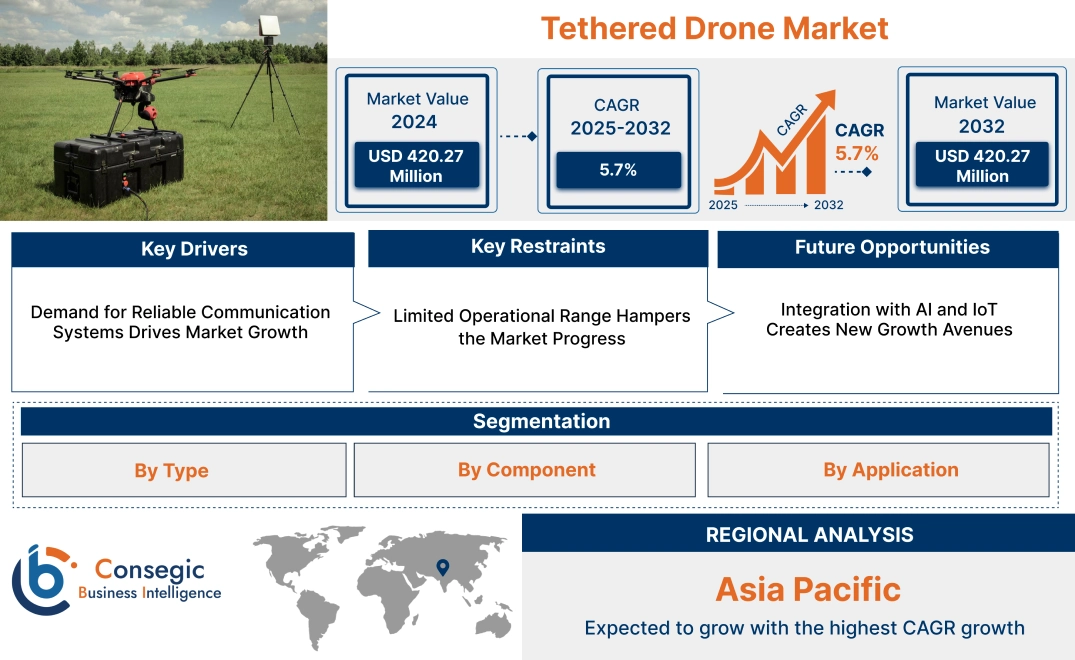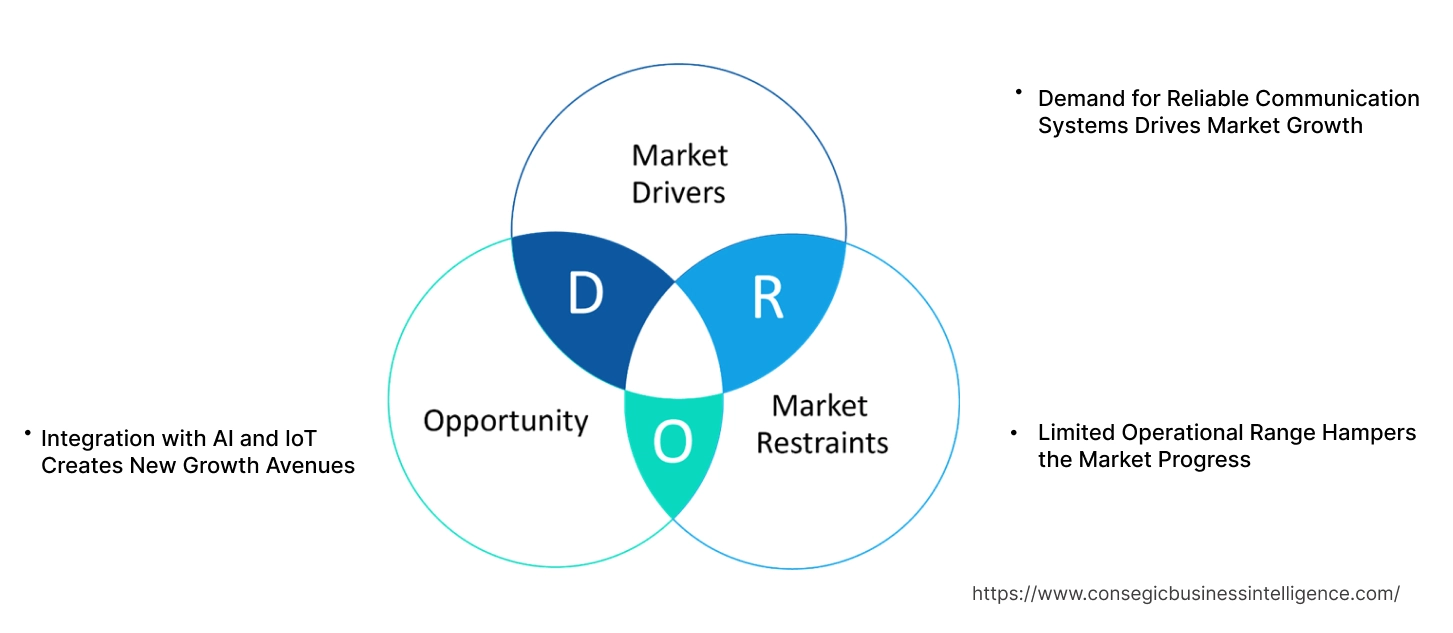- Summary
- Table Of Content
- Methodology
Tethered Drone Market Size:
Tethered Drone Market size is estimated to reach over USD 420.27 Million by 2032 from a value of USD 270.56 Million in 2024 and is projected to grow by USD 281.05 Million in 2025, growing at a CAGR of 5.7% from 2025 to 2032.
Tethered Drone Market Scope & Overview:
A tethered drone is an unmanned aerial system connected to a ground station through a physical tether that supplies power and enables data transfer. These drones are designed for extended flight durations and are widely utilized for applications such as surveillance, communication, and monitoring in industries including defense, public safety, and event management. The tether provides a continuous power supply, enabling the drone to operate for prolonged periods without relying on battery limitations.
These systems come equipped with advanced features such as high-definition cameras, thermal imaging sensors, and real-time data transmission capabilities. The tether not only ensures uninterrupted power but also provides a secure communication link, reducing the risk of signal interference. These drones are built for durability and stability, making them suitable for challenging operational environments and high-altitude applications.
End-users include law enforcement agencies, industrial operators, and organizations involved in critical infrastructure monitoring and event security. These systems play an essential role in providing reliable and long-duration aerial solutions for various operational needs.
Key Drivers:
Demand for Reliable Communication Systems Drives Market Growth
The increasing reliance on real-time communication during critical operations, such as emergency response and military missions, is driving the adoption of tethered drone systems. Unlike conventional drones that depend on wireless networks, these drones utilize cables to ensure uninterrupted and high-bandwidth data transmission. This technology is particularly advantageous in environments where wireless communication networks are unstable or unavailable, such as remote disaster zones or densely populated urban areas. These drones maintain a stable connection, allowing seamless streaming of live video feeds and sensor data to command centers, which is essential for situational awareness and decision-making. Their ability to provide continuous and reliable communication in demanding scenarios makes them a preferred choice for government agencies, defense forces, and industrial sectors requiring high-performance connectivity. Thus, as per the market trends, the aforementioned factors are driving the tethered drone market growth.
Key Restraints:
Limited Operational Range Hampers the Market Progress
Tethered drones are constrained by the physical length of their tether, typically ranging from a few hundred to a thousand meters. This limitation significantly restricts their ability to cover long distances or operate at extreme altitudes. While these drones excel in stationary or localized operations, their range constraints hinder their suitability for applications requiring broader area coverage, such as large-scale surveillance or remote inspections.
Additionally, the tether’s dependency on ground-based systems for power and data transmission further reduces the drone’s operational flexibility in dynamic environments. This range restriction poses restraints for industries and operations that demand extended mobility and adaptability, limiting the tethered drone market demand in certain sectors.
Future Opportunities :
Integration with AI and IoT Creates New Growth Avenues
The incorporation of artificial intelligence and IoT technologies is transforming the functionality of tethered drones, enhancing their application scope across industries. AI-powered analytics improve capabilities such as object detection, real-time tracking, and decision-making, enabling drones to perform complex tasks with higher precision. Meanwhile, IoT integration allows seamless connectivity with other devices and systems, facilitating data sharing and remote monitoring. These advancements are particularly beneficial for smart city initiatives, where these drones support real-time traffic management, environmental monitoring, and security operations. In industrial automation, IoT-enabled drones enhance operational efficiency by providing real-time insights for tasks like asset inspection and process optimization. The convergence of AI and IoT is unlocking new possibilities for drones, driving innovation, and creating significant tethered drone market opportunities.
Tethered Drone Market Segmental Analysis :
By Type:
Based on type, the market is segmented into quadcopter, hexacopter, octocopter, fixed-wing, and others.
The quadcopter segment accounted for the largest revenue of 44.5% of the total tethered drone market share in 2024.
- Quadcopters are preferred for their versatility in applications such as surveillance and communication due to their stability and ease of maneuverability.
- Their cost-effectiveness and operational simplicity make them ideal for commercial and defense applications, boosting their adoption across industries.
- Increasing technological advancements, such as enhanced flight control systems and payload capabilities, support the dominance of quadcopters.
- The analysis of segmental trends shows that the demand for quadcopters is further driven by their ability to operate effectively in restricted areas, enhancing their utility and contributing to the tethered drone market expansion.
The hexacopter segment is expected to register the fastest CAGR during the forecast period.
- Hexacopters are increasingly adopted for applications requiring enhanced stability and payload capacity, making them suitable for complex missions.
- Their ability to maintain flight even with motor failures offers reliability for critical operations like emergency response and environmental monitoring.
- Growing investments in research and development to improve hexacopter efficiency and flight time contribute to their rapid growth.
- As per the tethered drone market analysis, the expansion of the commercial drone sector fuels the adoption of hexacopters, particularly for high-performance applications.
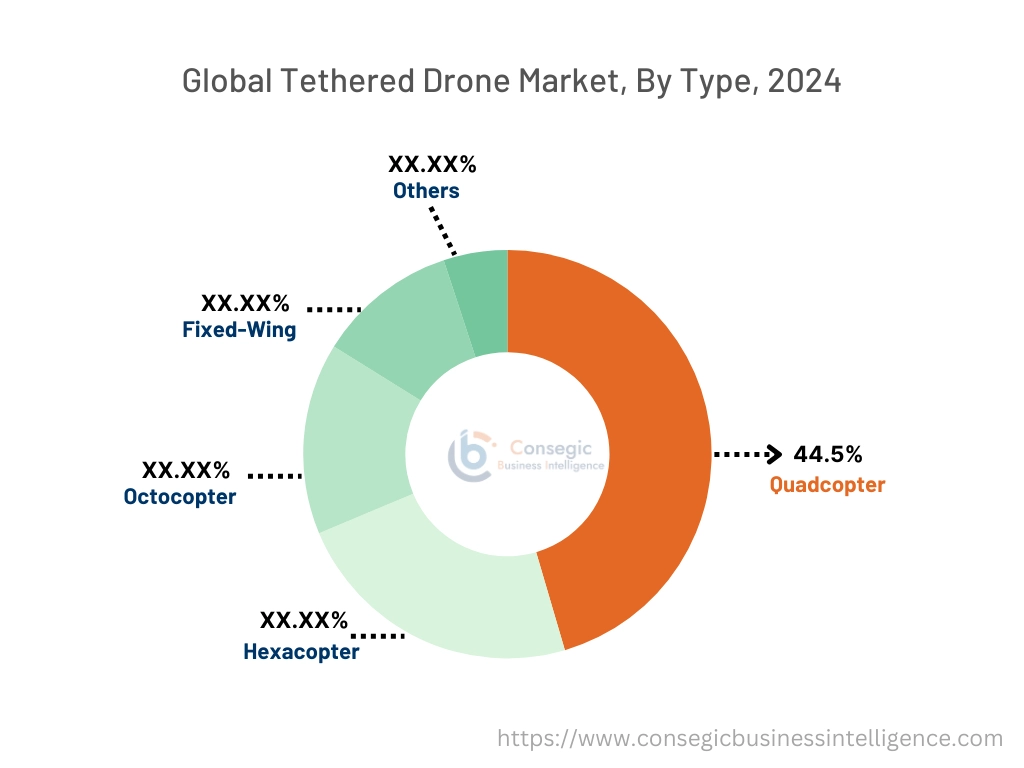
By Component:
Based on components, the market is segmented into hardware and software.
The hardware segment held the largest revenue of the total tethered drone market share in 2024.
- Hardware components, such as motors, propellers, and tether systems, are critical for ensuring the functionality and performance of tethered drones.
- Increasing advancements in camera technology enhance the capability of drones for high-resolution surveillance and monitoring applications.
- The durability and reliability of tether systems support their dominance in applications like defense and emergency response.
- As per market analysis, the significant investment in hardware innovation ensures continuous development of efficient and robust drones, driving the tethered drone market demand.
The software segment is projected to grow at the fastest CAGR during the forecast period.
- Navigation software enables precise control and operation of drones, which is essential for applications in surveillance and environmental monitoring.
- The integration of analytics software allows real-time data processing, enhancing decision-making for industries such as defense and communication.
- Increasing adoption of AI and machine learning in drone software supports automation and advanced analytics capabilities.
- As per the tethered drone market trends, the shift towards cloud-based drone management platforms accelerates the demand for software solutions in the market.
By Application:
Based on application, the market is segmented into surveillance, communication, emergency response, environmental monitoring, and others.
The surveillance segment held the largest revenue share in 2024.
- Surveillance applications benefit from the ability of tethered drones to provide continuous aerial monitoring with minimal interruptions.
- Defense and homeland security agencies heavily rely on surveillance drones for border monitoring and public safety.
- The capability to operate in harsh conditions with a consistent power supply ensures their prominence in critical surveillance missions.
- As per industry trends, the adoption of drones for surveillance is further supported by advancements in thermal imaging and night vision technologies, boosting the tethered drone market growth.
The emergency response segment is expected to register the fastest CAGR during the forecast period.
- Tethered drones are increasingly deployed for disaster management, providing real-time visuals to aid in rescue and relief operations.
- Their ability to maintain consistent communication links makes them ideal for emergency communication networks during crises.
- Growth in investments in smart city initiatives drives the use of these drones for rapid response in urban environments.
- Thus, as per the tethered drone market analysis, technological improvements, such as extended tether lengths and higher payload capacities, enhance their suitability for emergency response applications.
Regional Analysis:
The regions covered are North America, Europe, Asia Pacific, the Middle East and Africa, and Latin America.
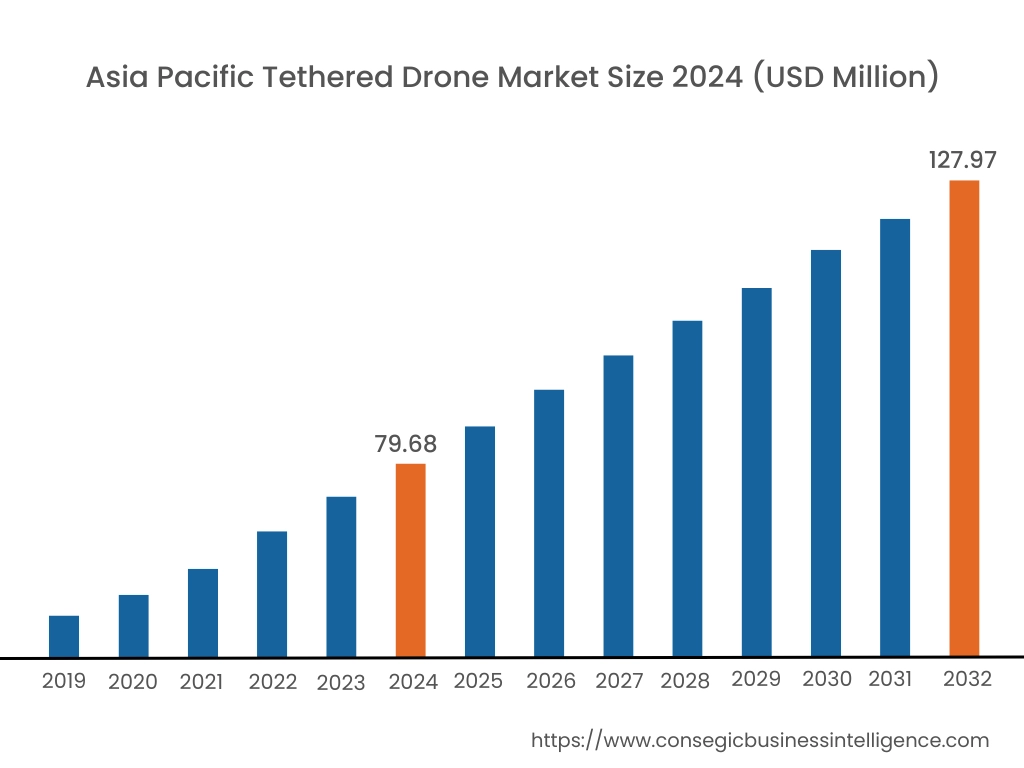
Asia Pacific region was valued at USD 79.68 Million in 2024. Moreover, it is projected to grow by USD 83.01 Million in 2025 and reach over USD 127.97 Million by 2032. Out of this, China accounted for the maximum revenue share of 34.1%. The Asia-Pacific region is witnessing rapid advancements in the tethered drone market, driven by industrial expansion and technological progress in countries such as China, Japan, and India. The increasing engagement of various technologies in smart farming is expected to drive market growth over the forecast period. As per the tethered drone market trends, technological improvements in the creation of drones and government initiatives are projected to generate profitable prospects for the industry.
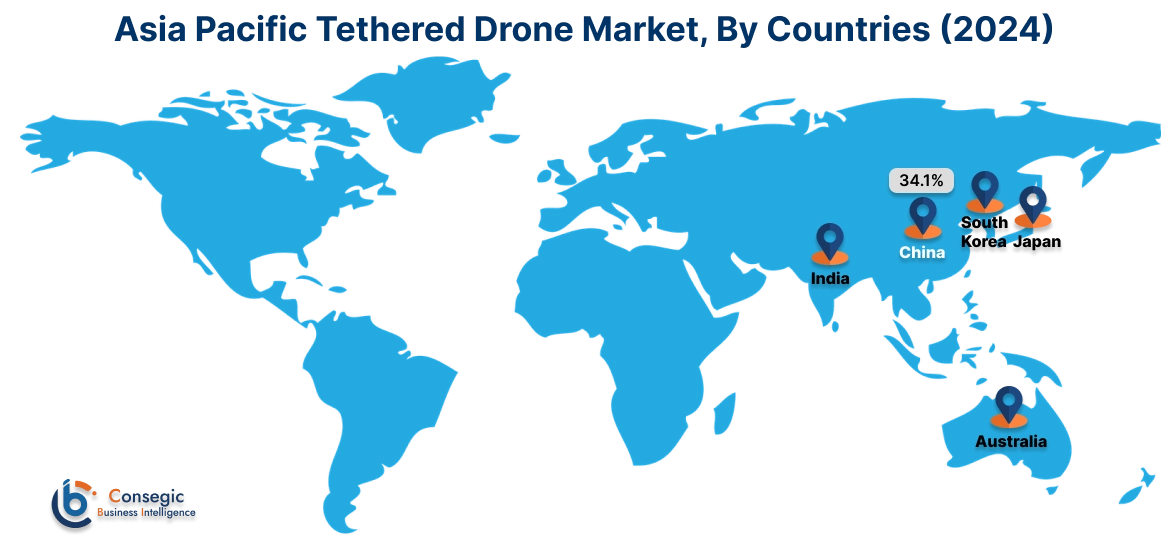
North America is estimated to reach over USD 136.21 Million by 2032 from a value of USD 89.75 Million in 2024 and is projected to grow by USD 93.05 Million in 2025. This region holds a substantial share of the tethered drone market, driven by the integration of advanced technologies and a strong presence of key industry players. The United States, in particular, emphasizes the use of these drones for military applications, including border security and defense of forward operating bases. A notable trend is the increasing adoption of drones for law enforcement and surveillance purposes. Analysis indicates that continuous investment in research and development, along with supportive regulatory frameworks, reinforces the region's market leadership thereby creating new tethered drone market opportunities.
European countries such as Germany, France, and the United Kingdom are actively investing in tethered drone technologies to enhance their defense and commercial capabilities. The region's focus on smart farming and infrastructure monitoring has accelerated the deployment of drones. A significant trend is the collaboration among European companies to develop advanced tethered drone systems for various applications.
The Middle East & Africa region is gradually embracing tethered drone technologies, particularly within the defense and oil & gas sectors. Nations like the United Arab Emirates are investing in innovative drone solutions to enhance service delivery and comply with international standards. Analysis suggests an emerging trend towards adopting these drones for surveillance and protection applications.
Latin America is an emerging market with countries such as Brazil and Mexico contributing to its development. The region's focus on modernizing IT infrastructure and improving business agility has spurred interest in tethered drone solutions. Government policies aimed at enhancing technological capabilities influence tethered drone market expansion.
Top Key Players and Market Share Insights:
The tethered drone market is highly competitive with major players providing products and services to the national and international markets. Key players are adopting several strategies in research and development (R&D), product innovation, and end-user launches to hold a strong position in the global tethered drone market. Key players in the tethered drone industry include -
- Elistair (France)
- Hoverfly Technologies (USA)
- Aerovironment, Inc. (USA)
- Azur Drones (France)
- Skydio, Inc. (USA)
- Drone Aviation Holding Corp. (USA)
- SkySapience Ltd. (Israel)
- Drone Volt (France)
- Yuneec International (China)
Recent Industry Developments :
Product Launches:
- In November 2023, Elistair launched KHRONOS, a fully automated tethered drone system for ISR missions, operable in GPS/GNSS and RF-denied environments. Deployable within two minutes, KHRONOS offers a 24-hour operational capability with a 10-kilometer radius view. Equipped with advanced mission software (T-Planner 2), it includes features like target tracking and automated categorization. Ruggedized for harsh conditions, the system is compact and easily integrates with vehicles, providing public safety, border patrols, and military forces with a versatile "pocket watchtower."
- In September 2023, Drone Evolution unveiled SENTINEL, a UK-designed tethered UAV system, at DSEI 2023. Paired with Steatite’s MPU5 MESH radio, it offers persistent surveillance with applications in ISR, force protection, and event security. Powered by the patented Freedom Power Supply Unit, it operates directly from 12V/24V vehicle power without inverters, reaching 50m altitude for up to 6 hours. SENTINEL's compact design, weatherproofing, and wind resistance make it ideal for challenging environments, providing versatile and mobile aerial monitoring solutions.
- In March 2023, Elistair launched the Orion Heavy Lift (HL) tethered drone, designed to support tactical communications for military, public safety, and homeland security applications. This drone can carry payloads of up to 5 kg at 50 meters for durations of 50 hours, providing flexible and secure mobile networks. Leveraging Elistair’s established Orion platform, it features ruggedized architecture, rapid deployment, and integration capabilities with various payloads like 5G relays and SIGINT systems. Orion HL ensures reliable communication coverage in challenging environments and operational conditions.
Tethered Drone Market Report Insights :
| Report Attributes | Report Details |
| Study Timeline | 2019-2032 |
| Market Size in 2032 | USD 420.27 Million |
| CAGR (2025-2032) | 5.7% |
| By Type |
|
| By Component |
|
| By Application |
|
| By Region |
|
| Key Players |
|
| North America | U.S. Canada Mexico |
| Europe | U.K. Germany France Spain Italy Russia Benelux Rest of Europe |
| APAC | China South Korea Japan India Australia ASEAN Rest of Asia-Pacific |
| Middle East and Africa | GCC Turkey South Africa Rest of MEA |
| LATAM | Brazil Argentina Chile Rest of LATAM |
| Report Coverage |
|
Key Questions Answered in the Report
What is the size of the Tethered Drone Market? +
The Tethered Drone Market size is estimated to reach over USD 420.27 Million by 2032 from a value of USD 270.56 Million in 2024 and is projected to grow by USD 281.05 Million in 2025, growing at a CAGR of 5.7% from 2025 to 2032.
What are the key segments in the Tethered Drone Market? +
The market is segmented by type (quadcopter, hexacopter, octocopter, fixed-wing, and others), component (hardware including motors, propellers, tether systems, and cameras, and software including navigation software and analytics), and application (surveillance, communication, emergency response, environmental monitoring, and others).
Which segment is expected to grow the fastest in the Tethered Drone Market? +
The hexacopter segment is expected to register the fastest CAGR during the forecast period, driven by its increased adoption for applications requiring enhanced stability and payload capacity.
Who are the major players in the Tethered Drone Market? +
Major players in the Tethered Drone Market include Elistair (France), Hoverfly Technologies (USA), Drone Aviation Holding Corp. (USA), SkySapience Ltd. (Israel), Drone Volt (France), Yuneec International (China), Aerovironment, Inc. (USA), Azur Drones (France), and Skydio, Inc. (USA).
